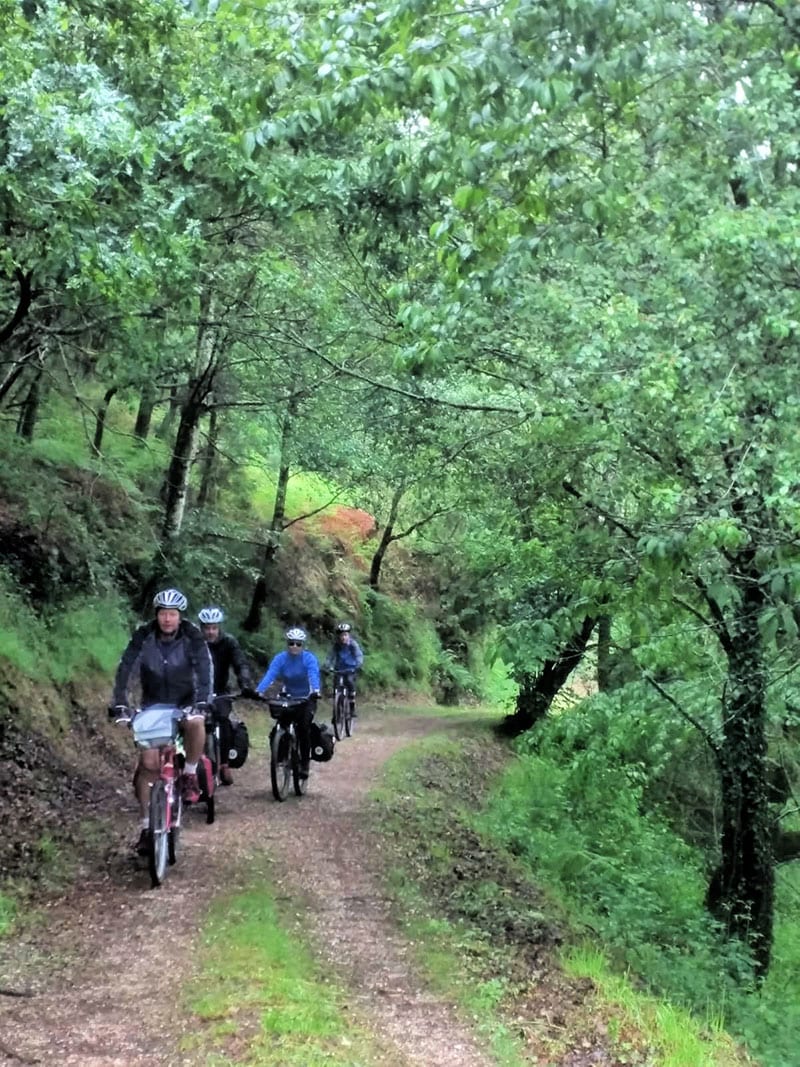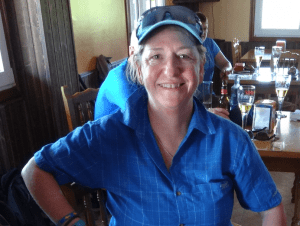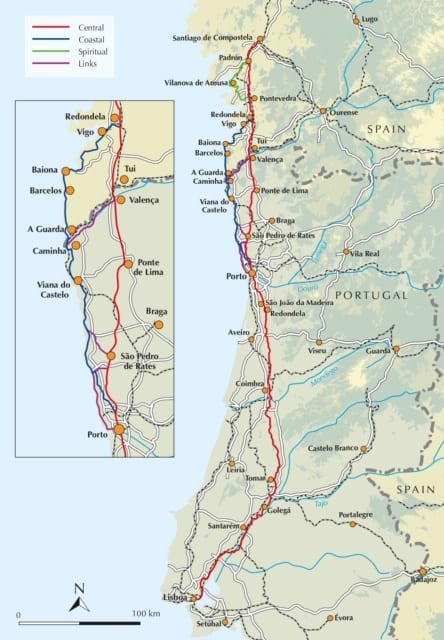Cycle the full length of the Portuguese Way from the cultured streets of Lisbon to Santiago de Compostela. Follow Portugal’s winding rivers and green valleys through to the verdant landscapes of Galicia, taking in cities like the medieval Ribeira of Porto and historic Coimbra along the way.
Camino de Santiago: Cycling the Portuguese Way
16 days / Self-guided cycling
Lisbon to Santiago de Compostela
Cycling the Portuguese Way
TRIP STYLE
DURATION/LENGTH
16 days/610 kms
DATES
Any date to suit you
START/END POINT
Lisbon to Santiago de Compostela
GRADING
Moderate
PRICE P/P TWIN SHARE
From EURO 1,875 / AUD 3,020

The Portuguese Way is a great Camino to tackle on two wheels. The roads are often rural and quiet, while the Portuguese are often rural and boisterous. You’d be hard-pressed to find friendlier terrain or people and don’t even get us started on the food. Lisbon, Porto and Santiago de Compostela are bursting at the seams with quality establishments, serving up everything from hearty local fare to Michelin-starred restaurants. The route through Portugal takes cyclists from Lisbon to Porto via the historic university town of Coimbra, then north to the Spanish border. From here, it’s three days’ ride to the cathedral in Santiago, along quiet roads lined with forests so green you could only be in Galicia.
Day 1 | Arrive in Lisbon
Make your way to Lisbon, the capital of Portugal, where the Tagus River joins the Atlantic Ocean. Lisbon is one of Europe’s most celebrated cultural centres, a cosmopolitan city boasting many historical sites including the Sao Jorge Castle, Jeronimos Monastery and the Belem Tower. Foodwise, you’d be crazy to miss out on pasteis de Nata (Portuguese custard tarts), bifano (pork sandwich), or bacalhau (salted cod). Eat up – you’ll be jumping in the saddle tomorrow and will need all the energy you can muster!
Day 2 | Lisbon – Vila Franca de Xira | 40 km | Level 2–3
Depart Lisbon after breakfast and begin your cycle along the Portuguese Way by following the famous Caminho de Fatima, which traces the Tagus River through the Parque das Nacoes. As you leave Lisbon behind, plenty of interesting countryside and lush valley scenery awaits, with the trail gradually climbing from Santa Iria de Azoia. Your efforts will be rewarded with a downhill section taking you into Povoa de Santa Iria, then it’s on to beautiful Vila Franca de Xira, a small city that is most famous for its bullfighting festival.
Day 3 | Vila Franca de Xira – Santarem | 62 km | Level 2–3
Continue along the Tagus River today, cycling inland towards Azambuja, a town known for the bull run that takes place in its streets every May. You’ll be thankful your bike weighs less than a bull as the Camino climbs to the highest point of the Portuguese Way, topping out in the town of Santarem. The views across the vineyards and orchards are wonderful, but it’s the history of Santarem that’s the real highlight. This was once one of the strongest fortresses in the entire kingdom, second only to Lisbon in terms of strategic importance, and in Roman times Julius Caesar used it as an administrative centre for his legions.
Day 4 | Santarem – Tomar | 60 km | Level 3–4
Continue along the Portuguese Way with the Tagus River for company, cycling down plenty of tranquil country lanes through quaint villages and farmland. This part of Portugal is famous for breeding horses and bulls, which you’ve no doubt realised given the importance of bulls at your last two overnights. Tonight’s destination is Tomar, a town of about 20,000 people, which was founded by the Knights Templar in the 12th century. The convent, castle and aqueduct are fantastic sights, while the Praza da Republica is an atmospheric square for a well-earned drink.
Day 5 | Tomar – Alvorge | 60 km | Level 4–5
Enjoy a day cycling along ancient Roman roads and farm tracks. It’s a tough, challenging section of the Portuguese Way, but the Camino rewards as usual with some terrific scenery to distract. There’s no shortage of olive groves either, while the tiny town of Alvorge promises a hearty meal, a few glasses of Portuguese wine and a good night’s rest to regain your strength for tomorrow’s ride.
Day 6 | Alvorge – Coimbra | 30 km | Level 3–4
A shorter day’s cycle means you’ll arrive in Coimbra with plenty of time to explore. This section is characterised by trees, with eucalyptus, pine and olive trees being constant companions along the Camino. Coimbra is a highlight of the Portuguese Way and a World Heritage-listed town, home to one of Europe’s oldest universities and what may well be the most beautiful library in the world. There’s energy around town thanks to the many students, so be sure to swap your two wheels for two feet and explore a little.
Day 7 | Coimbra – Agueda | 48 km | Level 3–4
After an initial climb to depart Coimbra, the Portuguese Way turns to a fairly flat and easy trail. You’ll see remains of the old Roman road as you pass through the vineyards of Mealhada, before continuing to the city of Avelas de Caminho, which has a strong historic connection to the Camino de Santiago. From here, it’s easy riding to the beautiful town of Agueda, set on the banks of the Certina River. For three weeks in July, the arts take over Agueda as the AgitAgueda Festival runs across town, but it’s otherwise a peaceful place. The Pateira de Fermentelos – the largest natural lake on the Iberian Peninsula – is also very close to town and worth visiting.
Day 8 | Agueda – Olveira de Azemeis | 40 km | Level 4–5
This section of the Portuguese Way will see you cycling through forests until you reach the Rio Marnel, from where you’ll continue to Albergaria A Velha. From here, the Camino continues across more woodlands and eventually arrives in the historic city of Oliveira de Azemeis, which has a population of approximately 20,000 people. It’s an important industrial town for the Porto region, manufacturing a range of essential goods, but it also has a number of pretty parks and churches, particularly the Igreja Paroquial de Valega.
Day 9 | Oliveira de Azemeis – Porto | 44 km | Level 3–4
Departing Oliveira de Azemeis after a hearty breakfast, you’ll cycle the Portuguese Way through Porto’s outskirts to arrive at its World Heritage-listed centre. This is Portugal’s second-largest city and one of Europe’s oldest, with a population of 1.5 million and 2000 years of history. Not only is Porto’s centre filled with history, it’s also home to colourful houses and winding cobblestone streets lined with wine bars and seafood restaurants. You can’t leave Porto without heading down to the docks and visiting the internationally renowned port houses. This is, after all, the home of port wine.
Day 10 | Porto – Arcos | 55 km | Level 2–3
Back in the saddle, you’ll begin the day at Porto’s cathedral, following your first yellow arrow out of town. Shake off the seafood and port and it won’t be long before you’re back cycling on quiet country roads, passing interesting historical sites like the Mosteiro de Leca do Balio on your approach to Arcos. A small town typical of the Portuguese Way, Arcos is a nice quiet spot compared to the hustle and bustle of Porto.
Day 11 | Arcos – Ponte de Lima | 57 km | Level 3–4
Cycle today through quaint villages and peaceful woodlands as the Portuguese Way continues its march towards Ponte de Lima. There’s an option to climb to the Chapel of Santa de Franqueira for fantastic views, while you’ll also pass through the medieval city of Barcelos. It’s famous as the origin of the Rooster of Barcelos, one of the most common symbols of Portugal, which comes from a folk tale to do with a pilgrim.
From Barcelos, continue cycling to Ponte de Lima, a former Roman settlement with an interesting history. The Roman soldiers believed that the River Lima resembled the mythical Lethe River, one of the five rivers of the underworld, and crossing it would strip a person of their memory. They refused to cross until a Roman general took his horse to the other side and called the soldiers over by their names, proving their fears to be unfounded.
Day 12 | Ponte de Lima – Tui | 36 km | Level 4–5
The Portuguese Way climbs out of Ponte de Lima to a high point of approximately 400 metres. It’s a challenging ascent, but one well worth the effort for the stunning views at the top. Keep cycling along undulating terrain, crossing hills through scenic landscapes, before the downward cycle to Valenca and the Minho River. Here, you’ll cross the bridge that separates Portugal from Spain and, once on the other side, you’ll have touched down in Galicia.
Day 13 | Tui – Pontevedra | 49 km | Level 4–5
After an enjoyable evening in the wonderful town of Tui, which is a great place to spend an extra night, begin the Spanish stage of your cycle along the Portuguese Way. Today’s ride will see you cycling through pine forests and postcard-perfect fishing villages to arrive in Pontevedra, a historic Camino town that always has a buzz about it thanks to the pilgrims approaching Santiago. Its large square, which is surrounded by impressive buildings, is a terrific place to people – or pilgrim – watch in the afternoon and evening.
Day 14 | Pontevedra – Padron | 40 km | Level 3–4
Your penultimate day along the Portuguese Way is a wonderful cycling day, passing chestnut groves and the hot springs of Caldas de Rei. Your destination is the tree-lined streets of Padron, a town famous for its celebrated writers and very, very spicy peppers. The riding is relatively manageable, so if exploring the thermal springs en route appeals, by all means do! They’re the perfect way to prepare for your final day’s ride to Santiago tomorrow.
Day 15 | Padron – Santiago | 24 km / Level 3–4
Well, it’s here. Your final leg of the Portuguese Way to Santiago de Compostela. It’s a short cycle today so there’ll be plenty of time to explore the city on foot. It’s a special, unique place with an inexplainable magic that can be only be experienced by walking around its ancient, cobbled streets. The historical centre is a World Heritage Site, with the most important building being, of course, Santiago Cathedral. This is where your cycling pilgrimage ends and there’ll no doubt be pilgrims streaming in from all over the country. Take some time to enjoy the moment, then head to the Compostela office to pick up your certificate of completion. Then, it’s time to celebrate! And there’s no better place to celebrate than in the streets of Santiago.
Day 16 | Finish in Santiago
Your cycling trip officially ends after breakfast this morning. We hope you’ve had a memorable experience cycling the Portuguese Way, and please note that additional nights can be added to this itinerary to include rest days and further time for exploration if requested.
Visit www.wanderingtheworld.com.au for more information.
Inclusions
- 15 nights accommodation, all carefully selected to enhance your Camino experience
- Private en-suite facilities
- Daily breakfast
- Information packs with route maps and instructions on how to locate hotels
- Pilgrim’s passport
- Emergency contact details and 24/7 local on-the-ground support
- Pre-departure and ongoing support from Australian office
Optional Inclusions
- Three-course dinners with local wine
- Daily luggage transfers from hotel to hotel (1 x 20kg bag unless indicated otherwise)
- Bike hire (27 speed BTT, plus repair kit, pump, lock & water bottle holder)
- Bike accessories – panniers (front and rear), bike seat gel cover, toe clips, helmet
- Suggested rest days as outlined in itinerary or if required
- Upgraded accommodation including paradors, country properties and premium/high-end styles
- Private vehicle transfers to the trip’s starting point
- Single supplement for your own room
- Additional night’s accommodation before or after trip (please advise at time of booking)
Not Included
- Flights
- Travel to trip’s starting point
- Transfers not already outlined in detailed trip itinerary
- Lunches
- Dinners
Accommodation
We know from personal experience that a good night’s rest can make or break a trip, which is why we carefully hand-select all our accommodation. We ensure that our knowledge and firsthand experience of the best places to stay is passed on to all our cyclists.
Your accommodation along the Camino is booked in advance, on a twin-share basis with private facilities, and chosen to make your journey as rewarding as possible. You may be staying in a refurbished farmhouse, some of which have been in the same family for centuries, or perhaps a boutique hotel with a chef who would not be out of place in a Michelin-starred restaurant. There are unique properties scattered throughout the different routes including converted monasteries, lighthouses and tiny B&Bs with the most generous hosts you could possibly imagine. Best of all, you’ll always have private en-suite facilities. Wherever you end up, you’ll be well looked after, warm and comfortable and, most importantly, ready to tackle the next day on your bike.
Single supplements are also available so you can enjoy your room with private en-suite. This supplement will apply if you are travelling alone or if there is no gender-share option. You can request a shared room through Wandering the World at the time of booking, however this is not guaranteed.
There are opportunities to upgrade to more luxurious lodgings in many places along the Camino. These are perfect for celebrating special occasions and milestones, or even to enhance your entire journey. We can recommend some very special, unique places to indulge in the Camino hospitality in spectacular style, so please ask us about these options when booking.
Food & Dining
The local cuisine is a definite highlight of your walk. The Camino regions are famous for their culinary delights, and you’ll end up exploring the destination using not only two wheels, but also your taste buds.
Breakfast at your place of accommodation is usually continental style and may include cereals, yoghurt, bread, pastries, ham, tea, coffee and juices.
Lunch – at your own expense – will depend on where you are on your walk and what is available. It’s often purchased at a local café or bar, with choices along the trail perhaps including Spanish omelette (tortilla Espanola), tuna empanadas, soups or sandwiches (boccadillo). Alternatively, you may wish to enjoy a picnic in a perfect spot along the path.
Evening meals are a hearty, three-course affair known as the ‘pilgrims’ menu’. These usually consist of a salad or soup to start, followed by a choice of a meat or pasta dish, then finishing with a dessert. This is always accompanied by a bottle of local wine, of course. On occasion, the owner of the accommodation may be in the kitchen preparing the house special, which will not disappoint.
Most evening meals are included on guided group trips, and for self-guided itineraries Wandering the World can include as many evening meals as you wish. We may strongly recommend this in some places because it’s either been a long day or there are limited choices available in certain destinations. We can share our advice and talk to you about this at the time of booking. We can accommodate most dietary requirements, so please let us know in advance.
THE CYCLING
This trip is a self-guided itinerary, ideal for groups and independent travellers who prefer to navigate in their own way and their own time.
You will be provided with an information pack including easy-to-read maps and instructions, complete with directions to guide you on the well-marked paths and tracks. On the Camino, you will be following the yellow arrows or the assigned roads and Camino scallop shells, while the Chemin is marked with red and white stripes, or directions to rural bike paths. This information pack will be available at your joining hotel on the first day of your trip.
TRIP GRADE ABOUT THIS CYCLING HOLIDAY
General difficulty: 3-5 (see the level of difficulty in each stage).
Level 1: mainly flat, without big slopes.
Level 2: small slopes, dirt roads.
Level 3: moderate slopes, dirt roads, sometimes challenging.
Level 4: big slopes, narrow tracks, challenging, sometimes rocky.
Level 5: big slopes, sometimes very difficult paths, paths over rocks.
LUGGAGE TRANSFERS – OPTIONAL
Wandering the World arranges a daily luggage transfer to maximise your comfort and enjoyment, or you can choose the option of a pannier rental to carry your own luggage if you wish. The luggage transfer allowance is one bag per person of no more than 20 kg (13 kg on the Chemin). Your luggage must be left in the reception of your hotel before breakfast (8 am) each day.
Please note:
- It is essential to attach the bag tag provided to ensure your luggage is delivered to your next accommodation.
- Only one bag will be moved each day and additional charges will apply if your bag is heavier than 20 kg (13 kg on the Chemin).
- Should you require special arrangements for additional luggage transfers, these can be made ahead of time and must be paid as part of your final payment to Wandering the World.
GROUP SIZE
Wandering the World’s guided groups have a maximum group size of 12 participants. This small group size means that we have the flexibility to stay in a wider range of accommodations, can dine together in the evenings, have the freedom to walk alone or together, and there are more opportunities to get to know your travelling companions.
WEATHER
The weather and climate on the Camino can vary from country to country, region to region and, of course, from day to day. Each season has its own benefits, with long, warm and sunny days in spring and early summer, while early spring and late autumn tend to enjoy cooler walking temperatures. Some sections may be too hot for walking mid-summer, while others are more likely to be wet at certain times. The experts at Wandering the World can discuss your preferences and guide you when you are planning your trip.
Once you’ve started your walk, the weather can play an important role in your overall enjoyment of the journey. Checking the forecast can be a great help when planning your days. If you do strike hotter weather, leaving early to avoid the warmest part of the day will make a huge difference.
24/7 SUPPORT & CARE
Your information pack will include details of local emergency contacts and international contacts. We have local, on-the-ground support to provide any assistance you may require and we’ll also check-in with your hotel at the end of each day to ensure that you’ve arrived safely.
GETTING THERE / GETTING HOME
This itinerary begins in Lisbon and ends in Santiago de Compostela.
The closest airports to Lisbon are Madrid, Lisbon or Porto
From your airport of choice there are bus, train and flight options as per the links below.
Train bookings are recommended. Please note you can only book two months in advance of the date of travel.
Bus: ALSA
Train:
Bus/Train : Rome2Rio
Flights:
Also, check out: Skyscanner
From Santiago de Compostela
You can catch the shuttle bus from Santiago city centre to the airport. Bus also stops at the bus station (Estación de Autobuses) and the train station (Estación de Ferrocarril). For more information go to www.empresafreire.com
If you wish to travel to Porto Airport there is a direct bus from Santiago once or twice a day (approx 4-6 hrs). More information available here www.alsa.es
INSURANCE
Insurance is compulsory for everyone who travels with Wandering the World. The insurance policy must include cover against personal accident, medical expenses, emergency repatriation and personal liability. Wandering the World recommends insurance coverage for cancellation to be taken at the same time your deposit is paid, as no exception to the cancellation provisions can be made.
BOOKING AND TRAVEL TERMS AND CONDITIONS
Wandering the World’s full booking terms and conditions are available upon request and will also accompany your initial invoice for deposit.

“Although I have chosen to walk 24 Caminos including the entire path from St Jean Pied de Porto through to Santiago de Compostela and onto Finisterre, I am still familiar with cycling in Europe and have thoroughly enjoyed the challenge on two wheels. One important consideration for choosing to cycle over a walk on the Camino is the degree of difficulty if you are not a cyclist. There are challenges particularly if you plan to start at the base on the Pyrenees and take on the mountains through to Pamplona. The shorter distances from Burgos, Leon or Porto on the Portugal Camino are less confronting, however I highly recommend only the experienced cyclists to take to the bike and others to stick with the walking”. – Glenyce, Founder of Wandering the World.

Hello Glenyce –
We are having a great trip! The bikes are fantastic. I was really worried about riding a mountain bike and they are perfect for the terrain plus they are well maintained quality bikes.
So far it has been a great adventure; we have gotten lost, fixed a flat, carried our bikes over 6 train tracks, ridden longer days than planned but every time we get to our hotel we are pleasantly surprised by our accommodations. They are expecting us, they have our bags, and we have rooms reserved near each other.
We are also enjoying selecting our own restaurants for dinner. The food has been fantastic!
All great!
Thank you!
Perleberg Family, Portugal Coastal from Lisbon 2023
